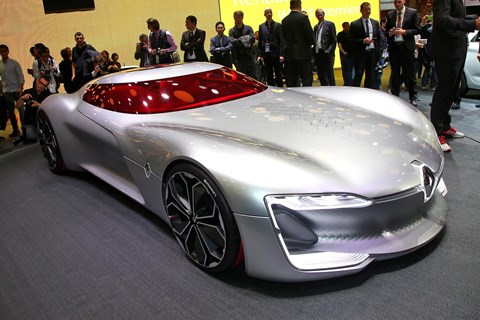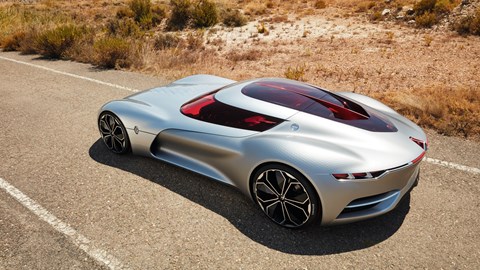► We speak to Laurens van den Acker, Renault’s design head
► ‘Ultimately, Renault wants to be selling hundreds of thousands of EVs’
► Autonomous driving tech will broaden styling scope
There’s a palpable sense of excitement as Renault’s senior vice president of corporate design, Laurens van den Acker, talks about the French firm’s new Trezor conept. ‘There’s less of a chance for design experimentation these days,’ he says, reflecting on the fact that successful car makers demands sales hit after sales hit.
Hear that? It was the sound of any remaining hopes of a second attempt at an Avantime evaporating.
Trezor: a show car in the traditional sense
The Trezor was no rushed flight of fancy to wheel something out in order to gain valuable column inches. Some 18 months’ worth of painstaking work has reputedly gone in to Renault’s vision for an electrically powered two-seat GT.
Specialist software and design processes allowed van den Acker and his team to tweak various styling elements, once the main shape had been established. Elements including the grille openings and side scalloping could be adjusted as though using a graphic equalizer, honing the final outcome. Doesn’t that replace the designer? ‘No,’ confirms the Dutchman, ‘it’s a tool to help make aspects of our job easier, enabling engineers to work more closely and identify where weight can be saved and aerodynamics perfected.’

There’s a sensuousness about not only the curvature and length of the Trezor’s form – and a mild hint of Saab Aero X concept, not least because of the tilt-forward canopy allowing for cabin ingress – but also courtesy of the textured bodywork, with defined hexagonal facets eased into the panelwork. ‘They can’t be done it steel – they’d lose their sharpness – but carbon fibre and plastics work well,’ says van den Acker.
Is there any room for design creativity these days?
Renault’s long been regarded as an innovator, introducing and popularising new concepts such as hatchbacks (5, 6 and 16) and MPVs (original Espace and Scenic) – but it was arguably late to the crossover carnival. Now it has three SUVs to its name, while the latest iterations of the Scenic family have a distinct crossover whiff about them.
Crossovers are clearly a valuable revenue source for a mainstream brand such as Renault but there’s a danger that, in the clamber to own an SUV, better products are overlooked. Van den Acker alludes to this, saying: ‘The Scenic is a more intelligent use of space but people want an SUV look. Who’d have thought just a few years ago we’d sell a Scenic with 20-inch wheels?’
EV designs set to remain fairly conventional
In response to ZE vehicle boss Eric Feunteun’s assertion that ‘Renault’s future was electric’, van den Acker was pressed further about whether EV buyers were more willing to embrace more advanced design than those considering conventionally propelled models.
You might think that, but while mainstream EV buyers want their cars to look distinctive, they’re reluctant to push boundaries too far – according to the design boss. ‘Ultimately, Renault wants to be selling hundreds of thousands of EVs, not just a few thousand.’
Scope for radical ZE designs is also narrowed, then.
Autonomous driving will shape future Renaults
Innovation isn’t dead at Renault, far from it – just that it’s going to focus more on powertrains, the packaging benefits EVs offer and – like every other major manufacturer – autonomous driving technology.
Styling-wise, what’s more important for Renault today is a recognisable face to reinforce a coherent, visual appeal the world over as it seeks to spread itself more effectively globally – and not just concentrate on Europe. The message now, heralded by the Trezor, is one of a styling evolution, not revolution.

Renault won’t be ditching the mainstream but its cars must remain attractive and desirable, vehicles people aspire to own: ‘Cars remain a status symbol,’ states van den Acker, and conceiving cars that become the class benchmark remains the goal of every designer.
Van den Acker doesn’t expect the advent of autonomous cars to quell this notion either, suggesting that while younger buyers may become less inclined to follow the traditional ownership path, older buyers will still want something that’s theirs: ‘You’re not going to want to share your pet, so why your car?’ he asks.
What’s clear is that as autonomous cars that are virtually impossible to crash become commonplace, that too will change the way cars look. ‘Will we need bumpers and crumple zones? Maybe not, but we will need at least 30 camera and sensor mounting points all around the car. And they will have to remain good to drive for when the driver wants to take over the wheel,’ reinforces van den Acker.
Desirable and attractive, electrically powered cars for Renault’s future, then. Just don’t bet your savings away on them being Trezor-shaped.
Click here for more news and features from Paris 2016